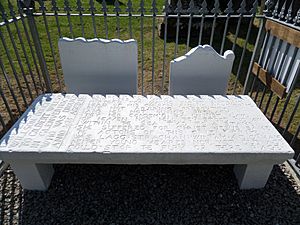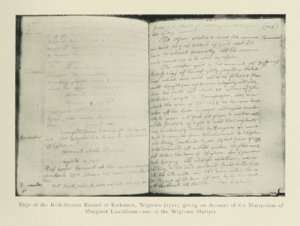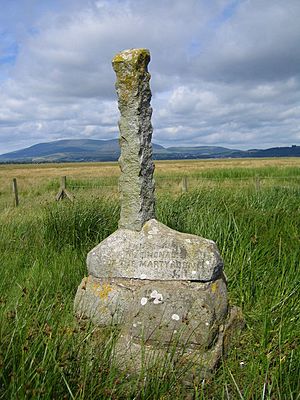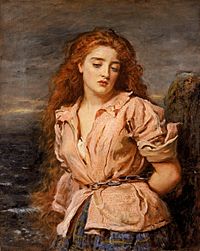Margaret Wilson (Scottish martyr) facts for kids
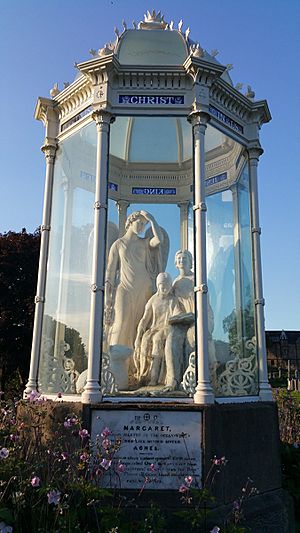
Margaret Wilson (born around 1667 – died May 11, 1685) was a brave Scottish teenager. She was a Covenanter, a group of people who believed in keeping the Church of Scotland free from royal control. Margaret was executed by drowning because she refused to promise loyalty to James VII of Scotland (also known as James II of England) as the head of the church. She died with an older woman named Margaret McLachlan. They became known as the Wigtown Martyrs. Margaret Wilson became especially famous because she was so young when she died for her beliefs. Her strong faith, even facing death, made her a celebrated figure in Presbyterian churches.
Contents
Why Margaret Wilson Was Arrested
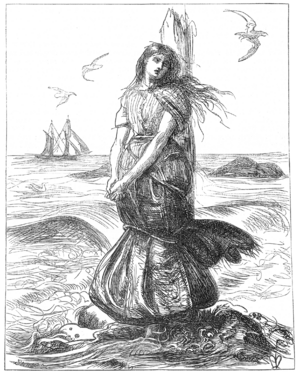
The Covenanters wanted to protect the changes made during the Scottish Reformation. They signed the National Covenant in 1638. This document opposed the king's control over the church. They wanted the church to be run by Presbyterian leaders, not by bishops chosen by the king. This disagreement led to wars and the king being overthrown.
When the king returned to power in 1660, the Covenants were declared illegal. The old system with bishops was brought back. Many ministers in Scotland, especially in the southwest, refused to accept this. They were banned from their churches. Instead, they held outdoor meetings called "conventicles." The government tried to stop these meetings using soldiers.
Margaret Wilson grew up on a farm near Newton Stewart in Wigtownshire. Her parents followed the king's church, but her older brothers were Covenanters. By 1684, Covenanters were hiding from the authorities. It became very dangerous to attend conventicles. Even small indoor gatherings were risky. If you refused to take an oath supporting the king, you could be put to death. This oath also meant rejecting the Covenant.
Despite the dangers, Margaret started going to conventicles with her younger brother, Thomas. Sometimes, their even younger sister, Agnes, came along too. They might have been inspired by James Renwick, a new leader of the Covenanters.
Margaret's Arrest and Trial
In February 1685, Margaret's sixteen-year-old brother, Thomas, left to join other Covenanters hiding in the hills. Margaret and Agnes secretly visited friends in Wigtown. One of these friends was an elderly widow named Margaret McLachlan.
The two sisters, Margaret and Agnes, were arrested. This might have happened after they refused to drink a toast to the King's health. They were put in a jail cell called the "thieves' hole." They refused to take the "Abjuration Oath," which meant rejecting the Covenant. The next Sunday, Margaret McLachlan was also arrested and put in the same cell with the Wilson girls and a servant woman.
They were brought before the government officials for Wigtownshire. On April 13, 1685, they were accused of being part of rebellions and attending many conventicles. They were found guilty of all charges. The three main people – Margaret Wilson, Margaret McLachlan, and the servant woman – were sentenced to a terrible death. They were to be "tied to poles fixed in the sand, within the sea's floodmark, and there to stand until the tide covered them."
A Reprieve and Its Sad End
The girls' father, Gilbert Wilson, traveled to Edinburgh. He asked the Privy Council of Scotland (a group of royal advisors) for mercy for all three women. He presented a petition saying that Margaret McLachlan had changed her mind. Agnes, the youngest sister, was allowed to go free after someone paid a bond for her. Reprieves, which are official delays of punishment, were written for the two Margarets. These reprieves were dated April 30, 1685.
The reprieve clearly stated that the execution of Margaret Wilson and Margaret McLachlan should be delayed. It also asked the King to grant them a royal pardon. However, a local official named Grierson of Lag chose to ignore this official order.
On May 11, 1685, just 11 days after the reprieve was signed, Margaret Wilson and Margaret McLachlan were chained to stakes. This happened on the Solway Firth coastline. As the saltwater rose and choked her, Margaret Wilson was allowed to pray for the King. She did so, but she still refused to reject the Covenant. This was not enough for her accusers. She was then forced back under the waves.
It is said that as the tide rose, she bravely quoted from the psalms and sang until she drowned. Margaret Wilson was about 18 years old when she died. She was buried with Margaret McLachlan in the churchyard of Wigtown.
Remembering the Martyrs
About 20 years after the execution, local church records were made. These records included stories from people who said they saw what happened. Margaret McLachlan's own daughter shared her account of her mother's drowning. The records also mentioned that Margaret Wilson's brother, Thomas, was still alive and could confirm the truth of these events.
The story of the Wigtown Martyrs was collected by Robert Wodrow. He published it in his book, History of the Sufferings of the Church of Scotland from the Restoration to the Revolution. The Church of Scotland asked Wodrow to gather these stories of persecution. He wrote that Thomas Wilson was still alive and ready to confirm everything he wrote. Wodrow's book was published in 1721. It greatly influenced how people viewed these events, even though some royalists tried to argue against it.
Later, a Scottish historian named Mark Napier questioned whether the drownings happened exactly as described. He published his doubts in books between 1859 and 1870. He pointed out the existence of the reprieve. However, church records from 20 years after the events provide detailed accounts from people who claimed to be eyewitnesses.
In Art and Books
Walker Art Gallery, Liverpool.
The death of Margaret Wilson was shown in a famous drawing by the artist John Everett Millais in 1862. This drawing appeared in a magazine called Once A Week. The magazine also printed the verses about her death that are carved on her grave in Wigtown.
Margaret Wilson's story is also discussed in the 1951 novel The Daughter of Time by Josephine Tey. In this book, a detective looks at how historical events can be changed to fit political ideas. Following Mark Napier's views, the book suggests that Margaret Wilson's death might be a myth. It mentions the reprieve and claims that early collectors of the story had trouble finding eyewitnesses. However, Robert Wodrow, who collected the stories, wrote that many people at the time tried to deny or downplay the event, even though it could be proven by many living witnesses.
Today, a statue showing Margaret Wilson's martyrdom is on display at Knox College in the University of Toronto, Canada.
See also
- Barbara Gilmour - another Scottish Covenanter.



